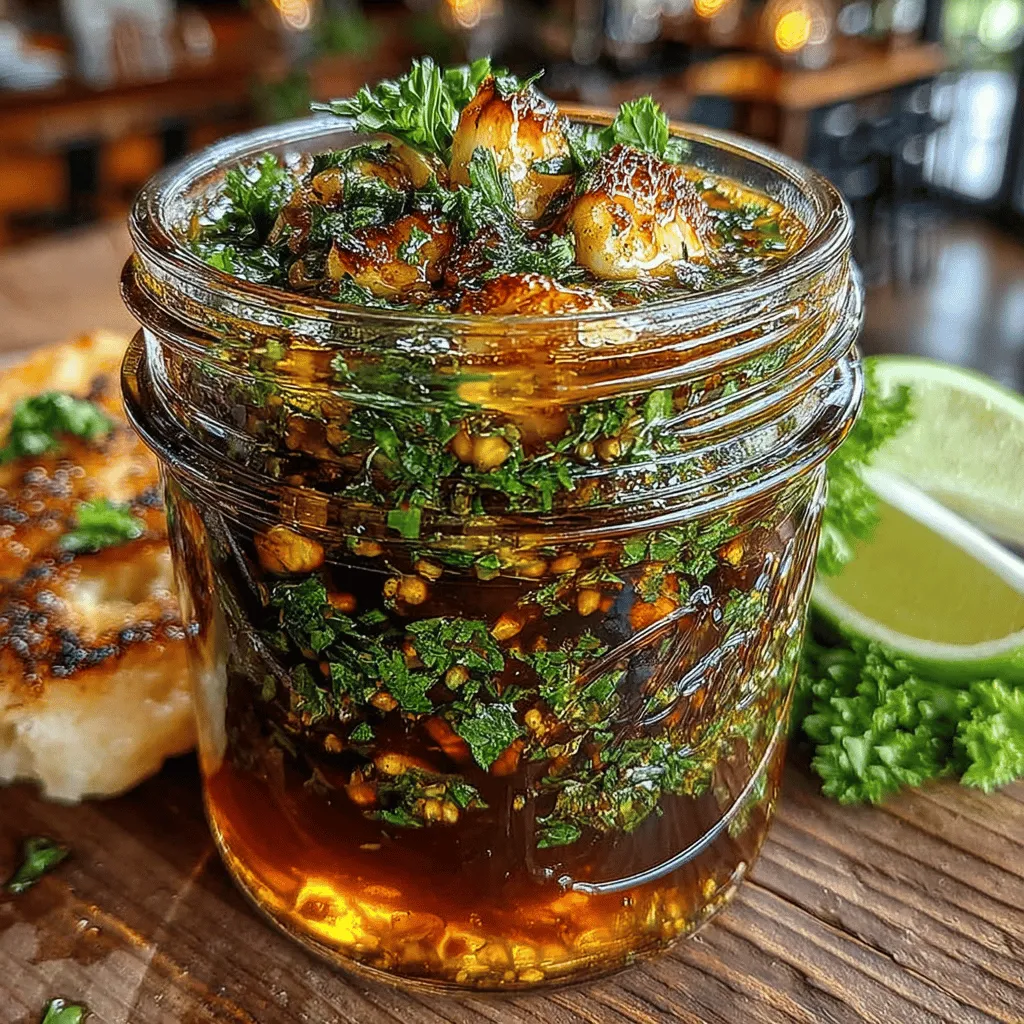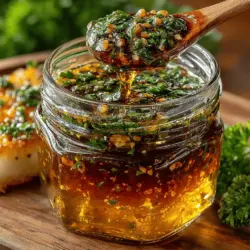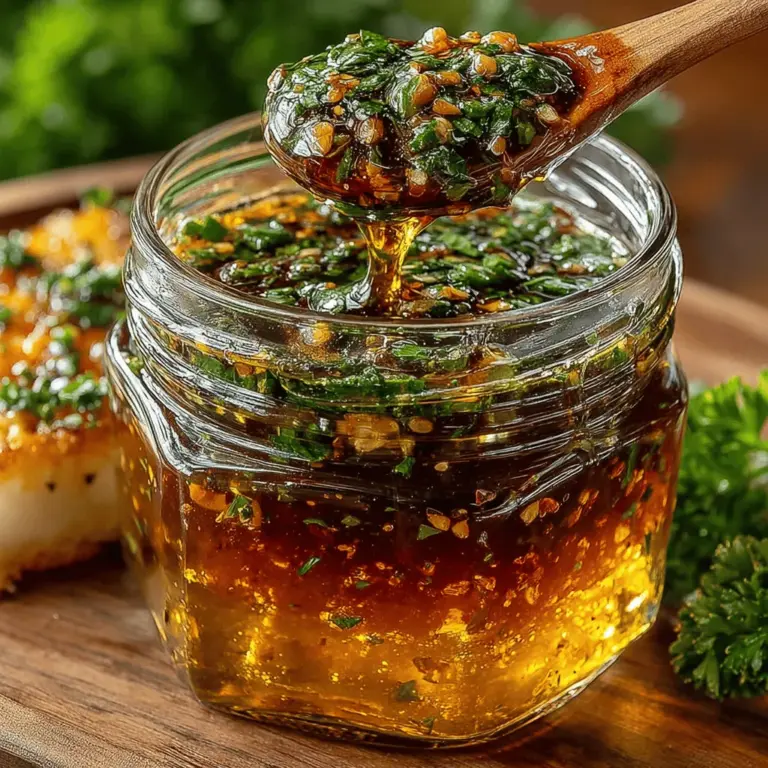Introduction to Herb-Infused Roasted Balsamic Vinaigrette
In the realm of culinary delights, few things can elevate a dish quite like a homemade vinaigrette. Among the myriad of options available, an herb-infused roasted balsamic vinaigrette stands out for its rich flavor profile and versatility. This dressing is not just a condiment; it’s a celebration of flavors that can transform a simple salad into a gourmet experience, enhance grilled vegetables, or serve as a delectable marinade for meats. In this article, we will explore the art of crafting this delightful dressing, detailing its components, preparation methods, and serving suggestions. By the end of this guide, you will not only have a delicious recipe at your fingertips but also a deeper understanding of the ingredients and techniques that make it exceptional.
Understanding the Ingredients
Balsamic Vinegar: A Flavorful Foundation
At the heart of any good vinaigrette lies a quality vinegar, and for this recipe, balsamic vinegar serves as the flavorful foundation. Originating from Italy, traditional balsamic vinegar is made from freshly crushed grape must, which is then aged in wooden barrels. This aging process results in a complex, sweet-tart flavor profile that is both rich and tangy. There are several types of balsamic vinegar available on the market, ranging from the luxurious, aged varieties to more commercial options that offer a milder taste. When selecting balsamic vinegar for your herb-infused roasted vinaigrette, aim for one that is well-balanced, with a good degree of sweetness and acidity. This ingredient will not only add depth to your dressing but also enhance the overall taste of any dish it accompanies.
Extra Virgin Olive Oil: The Heart of the Dressing
Extra virgin olive oil (EVOO) is the backbone of a vinaigrette, providing richness and body. Known for its robust flavor and health benefits, EVOO is made from the first cold pressing of olives, ensuring that it retains all the natural flavors and antioxidants. When crafting your herb-infused roasted balsamic vinaigrette, choosing a high-quality extra virgin olive oil is crucial. The peppery notes and fruity undertones of the oil will complement the sweetness of the balsamic vinegar, creating a harmonious balance in flavor. Additionally, EVOO is rich in monounsaturated fats, which are beneficial for heart health, making this dressing not only delicious but also a wholesome choice.
Sweeteners: Honey vs. Maple Syrup
The choice of sweetener in your vinaigrette can significantly impact its flavor profile. In this recipe, you have the option of using either honey or maple syrup. Honey offers a floral sweetness that can enhance the depth of the balsamic vinegar, while maple syrup provides a warm, earthy sweetness that can add a unique twist. When selecting a sweetener, consider your dietary preferences and any potential allergies. Both options are natural sweeteners, but honey may not be suitable for vegans. Maple syrup, on the other hand, is a great alternative for those seeking a plant-based option. The decision comes down to personal taste and the flavor nuances you wish to achieve in your vinaigrette.
The Importance of Fresh Garlic
Garlic is another essential ingredient in our herb-infused roasted balsamic vinaigrette. Roasting garlic transforms its pungent, raw bite into a sweet, mellow flavor that adds depth to the dressing. The process of roasting garlic involves slow cooking it in the oven until it becomes soft and caramelized, which mellows out its sharpness and brings out its natural sweetness. This technique not only enhances the flavor of the vinaigrette but also adds a lovely creaminess when blended into the oil and vinegar. Understanding the science behind roasting garlic can help you appreciate the complexity it brings to your vinaigrette.
Dried Herbs: Oregano and Thyme
Herbs play a pivotal role in flavoring your vinaigrette, and in this recipe, we will be using dried oregano and thyme. Both herbs have distinct flavors that complement the tangy notes of balsamic vinegar beautifully. Dried oregano has a warm, slightly bitter taste, often associated with Mediterranean cuisine, while thyme brings a subtle earthiness that rounds out the flavor profile. These dried herbs not only contribute their unique tastes but also offer a convenient way to add depth and complexity to the dressing without the need for fresh herbs, which may not always be available.
Seasoning: Salt and Pepper
No vinaigrette is complete without proper seasoning. Salt and pepper are critical components that enhance the flavors of all the other ingredients. Salt helps to bring out the natural sweetness of the balsamic vinegar and the richness of the olive oil, while black pepper adds a hint of spice that can elevate the overall taste. Adjusting the seasoning to your preference will ensure that your vinaigrette is well-balanced and flavorful, making it a standout addition to any dish.
Fresh Herbs: Parsley and Basil Garnishes
Finally, fresh herbs like parsley and basil serve as the finishing touch in our herb-infused roasted balsamic vinaigrette. While dried herbs provide a foundation of flavor, fresh herbs add brightness and freshness that can truly elevate the dressing. Chopped parsley can lend a vibrant green color and a refreshing taste, while basil adds a sweet, aromatic note that pairs exceptionally well with the balsamic vinegar. These garnishes not only enhance the visual appeal of the vinaigrette but also contribute an additional layer of flavor that can transform a simple dressing into something extraordinary.
Step-by-Step Guide to Making Herb-Infused Roasted Balsamic Vinaigrette
Prepping the Oven and Garlic
To kick off the process of making your herb-infused roasted balsamic vinaigrette, the first step involves preparing the oven and the garlic. Preheat your oven to 400°F (200°C). This temperature is ideal for roasting garlic as it allows the cloves to soften and caramelize without burning. Next, take a whole head of garlic, slice off the top to expose the individual cloves, and drizzle it with a bit of extra virgin olive oil. Wrap the garlic head in aluminum foil to create a small pouch; this will trap the steam and help the garlic roast evenly. Place the wrapped garlic in the preheated oven and let it roast for about 30 to 40 minutes, or until the cloves are golden and tender. The aromas that waft through your kitchen during this process will set the stage for the delicious dressing to come.
Mixing the Base Ingredients
While the garlic roasts, you can prepare the base ingredients for your vinaigrette. In a mixing bowl, combine 1/2 cup of balsamic vinegar with 1/2 cup of extra virgin olive oil. This ratio allows for a balanced flavor, but feel free to adjust according to your taste preferences. If you choose to use honey or maple syrup, add approximately 1 to 2 tablespoons to the mixture, depending on your desired level of sweetness. As you prepare these base ingredients, take a moment to whisk them together until they are well emulsified. The goal is to create a cohesive mixture where the oil and vinegar blend seamlessly. This is where the magic of the vinaigrette begins, as the flavors start to meld together in anticipation of the roasted garlic and herbs that will soon be added.

Crafting a delightful herb-infused roasted balsamic vinaigrette is a culinary endeavor that promises to elevate your meals. This section delves into the mixing process, emulsification techniques, flavor adjustments, serving suggestions, and storage tips, making it easier for you to create this versatile dressing.
Mixing Process: Order Matters
The order in which ingredients are combined is crucial for maximizing flavor infusion in your vinaigrette. Start by roasting your garlic and herbs, as the heat will release essential oils and flavors. Once cooled, minced garlic and chopped herbs should be added first to the bowl. This process allows the flavors to meld before the liquid ingredients are introduced.
Next, whisk together the balsamic vinegar and Dijon mustard in a separate bowl. The mustard not only adds a tangy flavor but also plays a key role in emulsifying the vinaigrette. After mixing the vinegar and mustard, gradually add the roasted garlic and herbs mixture. This step ensures that the flavors are well combined before adding the oil.
Finally, slowly drizzle in your olive oil while continuously whisking. This gradual addition helps in forming an emulsion, which is essential for achieving a smooth and cohesive dressing.
Emulsifying the Dressing
Emulsification is the process of combining two liquids that typically do not mix, such as oil and vinegar. In vinaigrettes, achieving a stable emulsion is essential for a smooth texture and balanced flavor. When you whisk the oil into the vinegar and mustard mixture, you’re creating tiny droplets of oil that are suspended within the vinegar.
To achieve the perfect emulsion, follow these tips:
1. Use Room Temperature Ingredients: Bringing your ingredients to room temperature helps them combine more easily.
2. Whisk Vigorously: The more you whisk, the better the emulsification. A steady, vigorous motion helps to break down the oil into small droplets.
3. Add Oil Slowly: By adding the oil gradually, you allow the vinegar to absorb the oil, leading to a stable emulsion.
If your vinaigrette separates, simply whisk it again before serving. You can also use an immersion blender for a super-smooth emulsion if you prefer a more modern approach.
Adjusting Flavors for Personal Preference
One of the most rewarding aspects of making your vinaigrette is the opportunity to tailor it to your taste. Adjusting the balance of sweetness and acidity can significantly impact the final flavor. Here’s how to do it:
– Sweetness: If you prefer a sweeter vinaigrette, you can add a touch of honey, maple syrup, or agave nectar. Start with a small amount (about 1 teaspoon) and taste as you go to avoid overpowering the vinaigrette.
– Acidity: If you enjoy a more tangy flavor, increase the amount of balsamic vinegar. A good rule of thumb is to maintain a 3:1 ratio of oil to vinegar, but feel free to tweak this depending on your preference.
– Salinity: Season with salt and pepper at the end, tasting as you go until you reach your desired level of seasoning.
Encourage experimentation with different types of vinegars or adding citrus zest for a fresh twist. This personalization will make your herb-infused roasted balsamic vinaigrette truly unique.
Incorporating Fresh Herbs
Fresh herbs are the heart of this vinaigrette, and timing their addition is key for maximizing their flavor impact. Here’s how to effectively incorporate them:
– Preparation: When using fresh herbs, wash them thoroughly and pat them dry. Chop them finely to release their oils and enhance their flavor.
– Timing: Add fresh herbs after the vinaigrette has been emulsified. This ensures that their vibrant flavors are preserved and not overwhelmed by the heat from cooking or mixing.
– Types of Herbs: While basil, parsley, and thyme are popular choices, feel free to experiment with other herbs like dill, chives, or even mint for a different flavor profile.
Adding fresh herbs at the right time not only enhances the vinaigrette’s flavor but also adds a beautiful aesthetic to the dressing.
Serving Suggestions for Herb-Infused Roasted Balsamic Vinaigrette
This vinaigrette is incredibly versatile and can enhance a variety of dishes. Here are some serving suggestions:
Drizzling Over Salads
The most common use for vinaigrette is drizzling it over salads. Here are a few ideas:
– Mixed Greens Salad: Combine various greens like arugula, spinach, and romaine. Add sliced cucumbers, cherry tomatoes, and red onions for a refreshing salad. Drizzle generously with the vinaigrette for a delightful flavor boost.
– Grilled Vegetable Salad: Toss together grilled zucchini, bell peppers, and asparagus. The roasted flavors of the vegetables paired with the herb-infused vinaigrette create a delicious and hearty salad option.
– Pasta Salad: Use the vinaigrette as a dressing for a cold pasta salad. Combine cooked pasta with cherry tomatoes, olives, mozzarella balls, and fresh basil for an Italian-inspired dish.
Using as a Marinade
Another excellent use for herb-infused roasted balsamic vinaigrette is as a marinade for proteins. Here are some ideas:
– Chicken: Marinate chicken breasts or thighs in the vinaigrette for at least 30 minutes before grilling or baking. The acidity of the vinegar tenderizes the meat while infusing it with flavor.
– Fish: For a light and zesty dish, marinate salmon or tilapia in the vinaigrette before roasting. The herbs will complement the fish beautifully.
– Tofu: For a vegetarian option, marinate cubes of tofu in the vinaigrette. This adds flavor and helps to create a delicious crispy exterior when grilled or baked.
Pairing with Roasted Vegetables
The vinaigrette also shines as a finishing touch for roasted vegetables. Here’s how to incorporate it:
– Roasted Root Vegetables: Toss diced carrots, parsnips, and sweet potatoes with olive oil, salt, and pepper, then roast until golden brown. Drizzle with the vinaigrette before serving for a flavorful enhancement.
– Brussels Sprouts: Roast halved Brussels sprouts until crispy. Just before serving, add a sprinkle of balsamic vinaigrette for a burst of flavor.
– Mixed Vegetable Medley: Combine your favorite seasonal vegetables—such as bell peppers, zucchini, and red onion—and toss with the vinaigrette before roasting to create a robust side dish.
Storage and Shelf Life
Proper storage techniques are essential for maintaining the freshness of your vinaigrette.
Proper Storage Techniques
– Containers: Store your herb-infused roasted balsamic vinaigrette in a clean glass jar with a tight-sealing lid. This helps preserve its flavors and prevents contamination.
– Refrigeration: Always refrigerate your vinaigrette. The cold environment slows down the degradation of flavors and keeps the herbs vibrant.
– Separation: It’s normal for the vinaigrette to separate after sitting. Simply shake or whisk it again before using.
Shelf Life Considerations
– Duration: When stored properly in the refrigerator, your vinaigrette can last for about one to two weeks. However, for the best flavor, aim to consume it within a week.
– Factors Affecting Longevity: The shelf life can be affected by the freshness of the herbs used and the acidity level. If you notice any off odors or colors, it’s best to discard the vinaigrette.
Conclusion: Embracing the Versatility of Herb-Infused Roasted Balsamic Vinaigrette
The herb-infused roasted balsamic vinaigrette is more than just a simple dressing; it’s a culinary tool that can enhance a variety of dishes, from salads to grilled meats. By understanding the ingredients, preparation methods, and serving possibilities, anyone can elevate their meals with this delightful vinaigrette.
With just a few simple steps, you can create a homemade dressing that not only tastes great but also showcases your culinary skills. Embrace the flavors and versatility of this vinaigrette, and let your creativity shine in the kitchen. Whether drizzled over a fresh salad, used as a marinade, or paired with roasted vegetables, this vinaigrette will become a cherished staple in your culinary repertoire.

